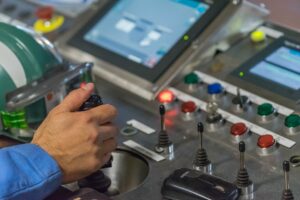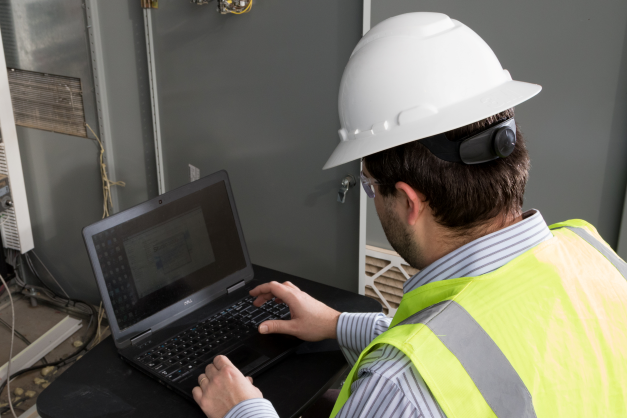
PLC Programmer on laptop
Are you considering direct-hiring a PLC programmer? Maybe you’ve heard people recommending to outsource this position. Is your facility in a position where your maintenance needs are becoming so large, that having somebody full-time on staff is sounding like it could take a load off your plate? If so, congratulations! You wouldn’t be at this position unless your company was experiencing some level of success. In today’s article I want to walk through the steps needed to ensure you make the right decision between outsourcing or direct hire.
Don’t Think About Hiring One Employee
To decide between outsourcing or direct hiring a PLC programmer, you first need to ask yourself a bigger question. Instead of asking “How do I hire ONE PLC programmer?”, you should be asking yourself “Should I hire THREE PLC programmers?”. Why? Because having a single employee in-charge of your automation is a recipe for disaster. You need an automation department, not an employee. Here are the top reasons
having a single employee in charge of your automation always ends in a headache:
Employee turnover
Lets face it. In todays job market, employee turnover is real. Imagine hiring an employee, training him for several months, only to have him leave a few months later and you having to start the process all over again. It happens. A lot.
One employee cannot be available 24/7/365
Most facilities run more that 40 hours a week. Even if your facility only runs 40 hours a week, down days and other events can push a single employee’s timecard well into the over time and double time category. Most employees are not looking to work 60 hours a week, week after week. This leads to burnout. This leads to turnover. See above.
Documentation accountability is a must
This is often overlooked. A single employee can get in the habit of “keeping it all in his head”. This is a great sign that the employee is well trained and can handle many problems in your facility. But it also places a lot of responsibility on that one individual. What if the employee calls in sick? What if an outside vendor needs information? What if the employee quits? Your documentation needs to be correct and complete at all times.
Bottom Line–Once you realize you need an automation department, not a single employee, then you can figure out if outsourcing or direct hire is right for you.
What If I Only Have Enough Work For One Person?
So you’ve realized that in a perfect world, you need an automation department, not a single employee. But you don’t have enough work or budget to hire a whole department. What do you do?
Outsource it. Hire an integrator. Most integrators offer “blocks of time” where their employees can be at your site for X number of hours per week. Remember, you need more than one person with knowledge of your facility. One “keeper of all the knowledge” is not an option.
Outsourcing Tips
Just because you hire an integrator to provide a “virtual automation department”, doesn’t mean that everything will be perfect. Here are the tips to make sure things are successful.

PLC’s and other automation equipment require specialized programmers to service.
Ensure they have multiple employees versed in your facility
Many integrators will be happy to provide a single PLC programmer at your facility on a regular basis. The problem is, this can have the same problem as you directly hiring an employee–if that employee leaves, you just lost a bunch of “tribal knowledge” and have start the training process all over again. Therefore, it is essential that the integrator have multiple employees familiar with your account. You may still have one single main contact with the integrator that does 80% of the work. But they need to have a team behind them that can pickup the pieces if they leave.
Make sure they are keeping documentation up-to-date
Keeping documentation up-to-date makes things more efficient for the integrator and for you. Additionally, it eases transitions between different programmers that may come out from the integrator.
Get the documentation
Some of the more unscrupulous integrators will gladly do all the work at your facility and then hold onto any documentation, backup programs or other essential info. This ensures repeat business for them at your expense. If you are paying them, it is your data, make sure you get it.
When To Direct Hire
If you facility is large enough that you can keep a full time staff of 3 or more people busy, having an in-house automation department can make sense. But, you still may want to keep a good relationship with an integrator for the following situations:
Capital projects
Experience has shown that capital projects are usually most cost efficient when performed by outside staff.
Oddball issues
Your in house automation department may be well versed to handle most of the day-to-day issues that arise. But there can be oddball issues where having an outside phone-a-friend is helpful.
Insider Knowledge
Most integrators are plugged into the latest happenings in the industry, through conferences, special trainings and other events. By having a relationship with them, you may be able to get info about upcoming product launches, discontinuations or issues that are not widely published.
Summary
In summary, no matter your size, you need an automation department. Not a single PLC programmer, but a team of multiple individuals that can spread out the work load and minimize the impacts of employee turnover. The good news is that no matter your size, you can have an automation department. If your organization is small, you may need to enlist an integrator to be your “virtual automation department”. If your organization is large, and can keep 3 or more people busy full time, you might be able to do it in house. Either way, having a good working relationship with an integrator can fill any gaps in your own staff.
If you are in need of an automation team let us know how we can help. ICAD Automation and Lighthouse Electrical both offer outside staffing services. Whether you are in need of 10 or 100 hours of help a week, we have the trained staff to meet your needs.

